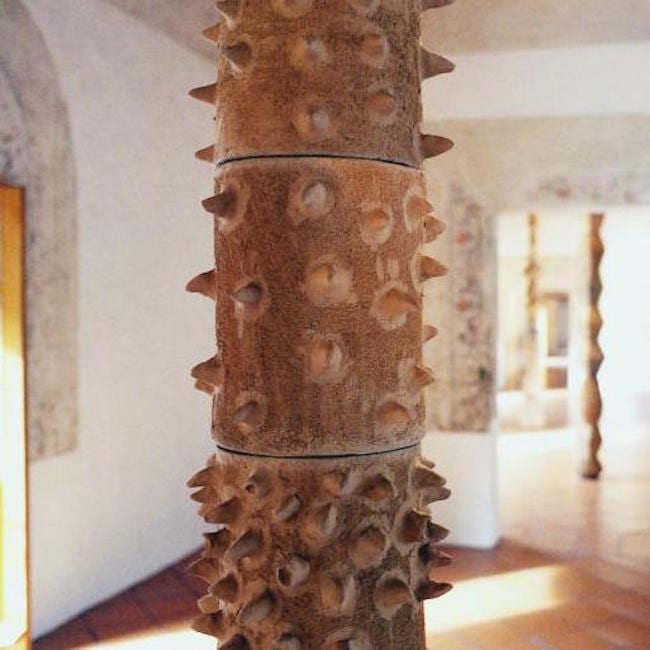Mariana Castillo Deball’s recent exhibition at the Museo de Arte Contemporáneo de Oaxaca, titled Who Will Measure the Space, Who Will Tell the Time?, (Oaxaca, Mexico, January 24 – April 20, 2015) is yet another extraordinary installation from one of Mexico’s leading and most widely-exhibited contemporary artists. This year she had an acclaimed show in Berlin (Mariana Castillo Deball: Parergon) at the Hamburger Bahnhof – Museum für Gegenwart Bruns) that projected the history of this City.

Her interest in ceramics dates back a few years. Her work for Uncomfortable Objects, 2012 for Documenta in 2013 was a mix of clay, shards, plaster, pigments, stones, shells, masks, fabric, glass, wood, clay and diverse objects mounted on a steel frame.

Mariana Castillo Deball, Uncomfortable Objects, 2012. Shown at Documenta 13, Kassel
Her Oaxaca exhibition is another triumph of this spatially ambitious artist and her quest is well described in the essay that follows by Curator Oliver Martínez Kandt. The works were produced with the assistance of Kythzia Barrera from Innovando la Tradición and the family Martínez Alarzón from Atzompa:

Mariana Castillo Deball, Parergon. Exhibition view. Photograph by Thomas Brunsmariana. Click to see a larger image.


The exhibition begins with a question about the line between time and objects, and how memory is filled with the present. How to tell the story of the Universe in a hundred years? How to tell the story of the Universe in one day?
Snake, kapok tree, gear, whipping top, horned warrior, Mother Earth, potter, pot, bat, screw, dog, corn, frog with a cell phone, root, lizard, pumpkin, elder, turkey, ceiba, infinite column.
This repertoire of objects, some archaeological, other mechanical, recreational or synthetic, were selected in the present, along with the Coatlicue pottery workshop based in Atzompa, Oaxaca. This selection was the foundation for imagining a series of stories, which were then used as a starting point for the sculptures, which stand in the exhibition space.
Who will measure the space, who will tell me the time? is situated on the thin line that divides our relationship with objects, with the stories we make about them. Perhaps, the language is not slippery, but the objects are. The use, or handling of an object is its reason for being and simultaneously its exhaustion, their complete disappearance.
The working process of Castillo Deball begins with a question that is gradually inhabited by different characters. Some are fictitious, others, historical figures; together they begin to weave an intricate network. With a language often inconsistent, discursive, formal or poetic, Deball Castillo uses these characters to display her interest in the specificity of forms and voices.


In the project Who will measure the space, who will tell me the time?, Deball Castillo investigates the relationship Atzompa potters have with their archaeological heritage and how it is expressed, contaminated or dissolved in the present. Far from taking a purist stance, this work began with a series of discussions on the copies, forgeries, style changes and influences in the history of Mexican archeology.
Together with Kythzia Barrera from Innovando la tradición and the family Martínez Alarzón from Atzompa, we visited the archaeological museum Rufino Tamayo and selected our favorite pieces. To this set of pieces, we added a lot of nuts and gears found in Ramiro´s workshop, also a whipping top, a ball, and other belongings, to form a repertoire, a vocabulary to tell our stories.


Maybe you can tell a story from anything, maybe the objects define the kind of story to be told.
The procedure was similar to the surrealist exquisite corpse, Chinese whispers or any other assembly or gossip that adds fragments gradually.
The group split in two. The main exercise was to develop a story which spans one hundred years, and one that happened in one day. This resulted in a story of the origin of the Universe in one hundred years, and another about the origin of the Universe in one day. The two stories are almost the same. Then came the story of the journey of a potter, since he wakes up at dawn to prepare the clay until he finish the pieces, burn them, and then leaves to sell them in order to buy corn to eat.
Every character became clay, and at the gallery, we ordered them in columns which reach the ceiling, so visitors can surround the stories of top-down and bottom-up.

This project challenges the idea of a static tradition that should not be changed in order to exist, broadening the debate of what archeology is in the present and how it can be constantly updated to resignify visual identity panoramas. Who will measure the space, who will tell me the time? is a project in collaboration with the Coatlicue ceramics workshop (family Martínez Alarzón) and Innovando la tradición. Produced by the Museo de Arte Contemporáneo de Oaxaca.
The exhibition Who will measure the space, who will tell me the time? is accompanied by the publication ‘Ixiptla Vol. 3.’ This edition of Ixiptla is focused on the trajectory of objects collected and produced by archeologists – plaster molds, facsimiles, drawings, photographs, and scale models – in an attempt to capture and replicate material evidences left by time; these objects emerge from a specific moment in time, producing a doppelgänger of the original milieu, which then takes its own course.

Ixiptla derives from xip, meaning: skin, cover, shell; is the container, the recognizable presence, the update of a force embedded in an object: a being there, removing the distinction between essence and matter, original and copy. Therefore, the ixiptla and the image take different paths. Ixiptla is the overwhelming manifestation of a presence.
Any thoughts about this post? Share yours in the comment box below.










Add your valued opinion to this post.